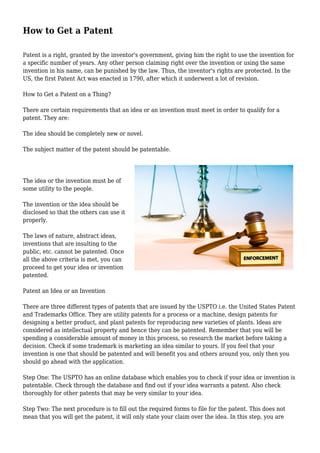How to Get a Patent
- 1. How to Get a Patent Patent is a right, granted by the inventor's government, giving him the right to use the invention for a specific number of years. Any other person claiming right over the invention or using the same invention in his name, can be punished by the law. Thus, the inventor's rights are protected. In the US, the first Patent Act was enacted in 1790, after which it underwent a lot of revision. How to Get a Patent on a Thing? There are certain requirements that an idea or an invention must meet in order to qualify for a patent. They are: The idea should be completely new or novel. The subject matter of the patent should be patentable. The idea or the invention must be of some utility to the people. The invention or the idea should be disclosed so that the others can use it properly. The laws of nature, abstract ideas, inventions that are insulting to the public, etc. cannot be patented. Once all the above criteria is met, you can proceed to get your idea or invention patented. Patent an Idea or an Invention There are three different types of patents that are issued by the USPTO i.e. the United States Patent and Trademarks Office. They are utility patents for a process or a machine, design patents for designing a better product, and plant patents for reproducing new varieties of plants. Ideas are considered as intellectual property and hence they can be patented. Remember that you will be spending a considerable amount of money in this process, so research the market before taking a decision. Check if some trademark is marketing an idea similar to yours. If you feel that your invention is one that should be patented and will benefit you and others around you, only then you should go ahead with the application. Step One: The USPTO has an online database which enables you to check if your idea or invention is patentable. Check through the database and find out if your idea warrants a patent. Also check thoroughly for other patents that may be very similar to your idea. Step Two: The next procedure is to fill out the required forms to file for the patent. This does not mean that you will get the patent, it will only state your claim over the idea. In this step, you are
- 2. needed to submit a description of the idea, its use, its usability, and its sketch (for inventions). This is known as the Provisional Patent Application or the PPA. Step Three: The next step is the filling up of the Regular Patent Application or the RPA. This procedure kick-starts the examination of the patent by the USPTO. If it does not find any similar patent approved previously and does not object, the next step becomes very easy. Further, it is mandatory to file for this application within a year of filing the PPA. Step Four: Once the USPTO has no objections, your idea is granted a patent on payment of the final fee. You get the proprietary rights and you become the sole owner of your idea. Cost of Getting a Patent If you file for a patent and do the applications yourself, it will cost you less. For this, it is mandatory that you know the complete procedure and its fee. The patent fee amount is inclusive of filing fee, patent search fee, and the examination fee. If your application is accepted, there will be a further fee towards getting your patent issued. The drawback of this procedure, however, is that it will take you at least a year or two to get your idea patented. On the other hand, if you were to go to a patent attorney, you will have to shell out a lot of money for this procedure. However, you will not have to wait for a year to get your idea patented. This saves you the risk of losing your invention to someone else and also saves you from the trouble of getting involved in this complicated procedure. The cost of getting a patent is varies from country to country, and international patents cost more.

